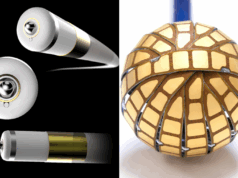The Arctic Front Cryoballoon from Medtronic is safe with very low incidence of pulmonary vein stenosis and no cryo-related left atrial perforation and low thrombogenic risk. Results were presented by Wyn Davies, London, UK, at the annual Europe AF meeting in London, UK.
The Arctic Front is a double balloon safety system with a bi-directional deflection system over-the-wire.
It has two balloon diameters (23 and 28 mm), 100 cm usable length, 10 mm distal tip and a 10.5F outer diameter shaft. It is compatible with the 12F ID FlexCath Steerable Sheath.
“This is another technology where occlusion is crucial, and the better the level of occlusion, the better the outcome from therapy,” stated Davies, before presenting some published results.
Pulmonary vein isolation using one cryoballoon (28 mm Arctic Front) was performed in twenty patients, age 56±9, atrial fibrillation duration 7±6 years, antiarrhythmic drugs 2.5±1, left atrium size 40±5 mm, four patients had structural heart disease.
72/74 (97%) pulmonary veins were isolated, fluoroscopy time 59 ±21 minutes and balloon time 140±56 minutes. Follow up of 89 ±66 days: 15 patients (75%) were free of atrial fibrillation and there was reduced atrial fibrillation in five patients. There were no complications except for one pulmonary nerve palsy after balloon leakage leading to distal positioning in the right superior pulmonary vein.
In a prospective three centre study Neumann et al performing circumferential pulmonary vein isolation with the cryoballoon technique, of 346 patients, 293 (85%) had paroxysmal atrial fibrillation and 53 (15%) persistent atrial fibrillation. Atrial fibrillation duration was 6.5 years, left atrial diameter 40 mm, procedural time 170 minutes and fluoroscopic time 40 minutes. Pulmonary vein isolation was achieved in 97% of 1403 pulmonary veins.
“We compared our contemporary experience with conventional radiofrequency ablation for first time paroxysmal atrial fibrillation patients,” said Davies.
In Davies’ own published comparison of cryo versus radiofrequency ablation for atrial fibrillation, ninety paroxysmal atrial fibrillation subjects underwent cryo-ablation. Follow-up was 14.9±7.7 months, procedural time 108±28 minutes and fluoroscopic time 27±9 minutes. There was one pericardial effusion and two transient phrenic nerve palsies. Fifty three patients underwent conventional radiofrequency ablation. Follow-up was at 15.6±7.4 months, procedural time 208±58 minutes and fluoroscopic time 62±36 minutes. There were two pericardial effusion unrelated to transseptal puncture requiring drainage
Pulmonary vein occlusion with the Arctic Front is acutely effective when warming by the blood pool is eliminated and atrial fibrillation ablation is simplified. Outcomes following pulmonary vein isolation with the Arctic Front are comparable to radio frequency ablation. Procedure and fluoroscopy times are reduced and future developments will drive single puncture procedures, concluded Davies.
Retraction
This article was originally published in Cardiac Rhythm News issue 11 in February 2011. The radiofrequency ablation results are part of a study conducted by Wyn Davies, London, UK and not the STOP-AF trial.









